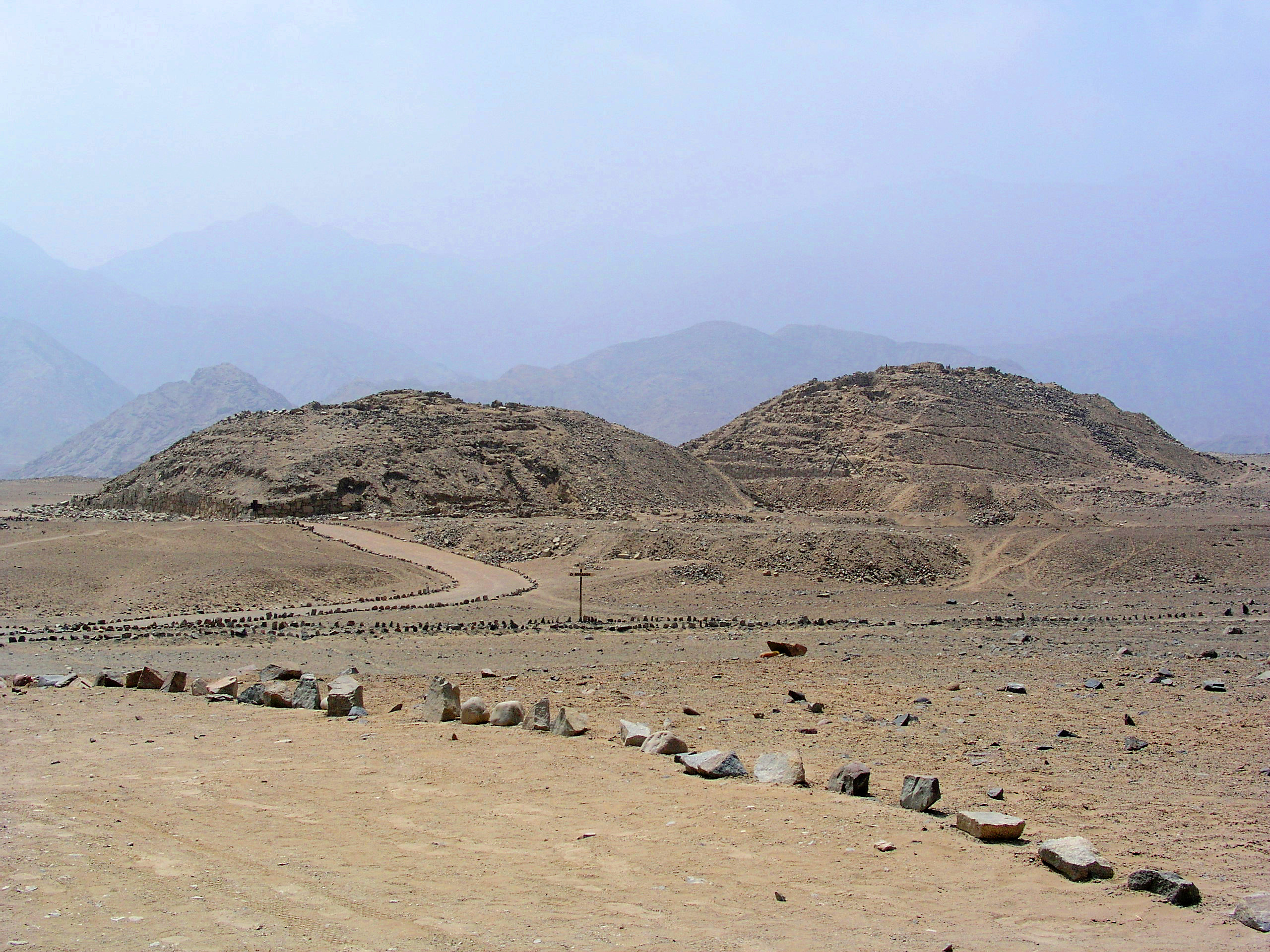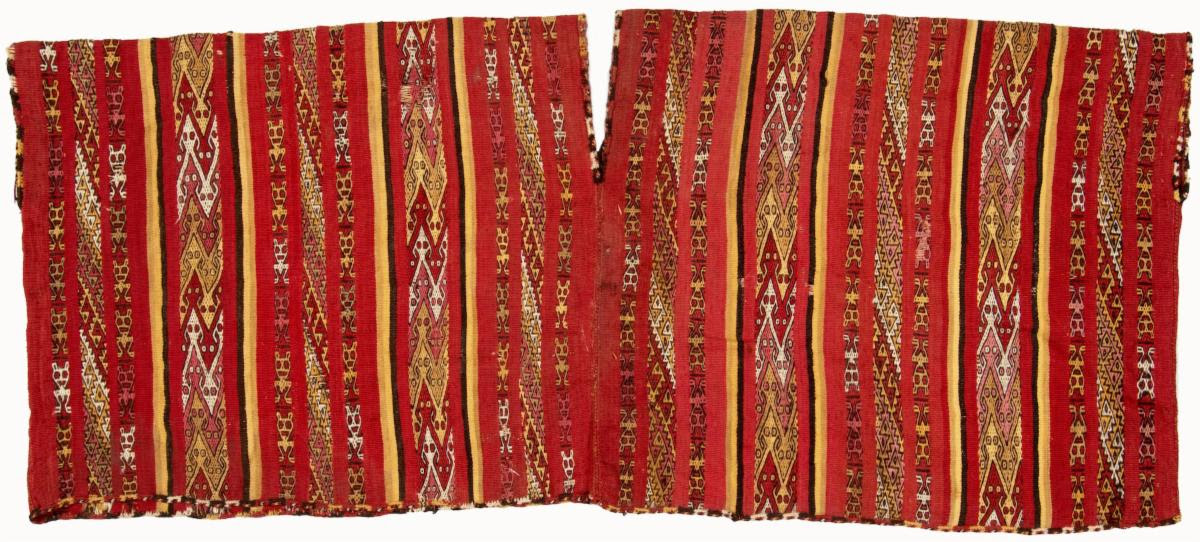|
Sechin Alto
Sechin Alto is a massive architectural complex in Peru belonging to the Early Formative period (2000-1500 BC). It is located in the Casma Province, the Ancash Region, on the left bank of the Sechín River, east of the town of the same name. Other important archaeological sites such as Cerro Sechin and Sechin Bajo are located nearby. Studies Archaeologist Julio C. Tello was the first to make a thorough description of this archaeological site during his visit to the valley of Casma in 1937. He determined that this was the largest architectural structure not only in Peru, but in all of the Americas. The site was later studied by archaeologists :es:Rosa Fung Pineda and Carlos Williams (1979), and by Thomas and Shelia Pozorski (1987). Description The main structure, called "Templo", has a pyramidal shape. It measures 350m by 300m, and reaches the height of 35m. It consists of raised embankments and walls with large stones alternating with smaller ones; conical adobe bricks are seen i ... [...More Info...] [...Related Items...] OR: [Wikipedia] [Google] [Baidu] |
Peru
, image_flag = Flag of Peru.svg , image_coat = Escudo nacional del Perú.svg , other_symbol = Great Seal of the State , other_symbol_type = Seal (emblem), National seal , national_motto = "Firm and Happy for the Union" , national_anthem = "National Anthem of Peru" , march = "March of Flags" , image_map = PER orthographic.svg , map_caption = , image_map2 = , capital = Lima , coordinates = , largest_city = capital , official_languages = Peruvian Spanish, Spanish , languages_type = Co-official languages , languages = , ethnic_groups = , ethnic_groups_year = 2017 , demonym = Peruvians, Peruvian , government_type = Unitary state, Unitary Semi-presidential system, semi-presidential republic , leader_title1 = President of Peru, President ... [...More Info...] [...Related Items...] OR: [Wikipedia] [Google] [Baidu] |
Las Haldas
Las Haldas or Las Aldas is a large archaeological complex from before and during the initial ceramic period (1800–1000 BCE) of Peru. Las Haldas is located on the Pacific coast approximately north of Lima and about south of the Casma river valley, noted for the extensive ruins of the Casma-Sechin culture. For most of its history Las Haldas, a coastal community, coexisted with the inland agricultural communities in the Casma River Valley. Distinguishing characteristics of Las Haldas are both its size and age as one of the earliest ruins of the ceramic period, its dependence upon maritime resources for subsistence, the lack of agriculture, and its distance from any source of fresh water. Las Haldas is in a coastal area in which are found the oldest known civilizations of the Americas. The Casma valley archaeological sites are a few miles north and the Caral-Supe civilization is about to the south. Discovery and description Las Haldas was discovered in 1956 and has sin ... [...More Info...] [...Related Items...] OR: [Wikipedia] [Google] [Baidu] |
Archaeological Sites In Ancash Region
Archaeology or archeology is the scientific study of human activity through the recovery and analysis of material culture. The archaeological record consists of Artifact (archaeology), artifacts, architecture, biofact (archaeology), biofacts or ecofacts, archaeological site, sites, and cultural landscapes. Archaeology can be considered both a social science and a branch of the humanities. It is usually considered an independent academic discipline, but may also be classified as part of anthropology (in North America – the four-field approach), history or geography. Archaeologists study human prehistory and history, from the development of the first stone tools at Lomekwi in East Africa 3.3 million years ago up until recent decades. Archaeology is distinct from palaeontology, which is the study of fossil remains. Archaeology is particularly important for learning about prehistoric societies, for which, by definition, there are no written records. Prehistory includes ove ... [...More Info...] [...Related Items...] OR: [Wikipedia] [Google] [Baidu] |
Peter Kaulicke
Peter may refer to: People * List of people named Peter, a list of people and fictional characters with the given name * Peter (given name) ** Saint Peter (died 60s), apostle of Jesus, leader of the early Christian Church * Peter (surname), a surname (including a list of people with the name) Culture * Peter (actor) (born 1952), stage name Shinnosuke Ikehata, Japanese dancer and actor * ''Peter'' (album), a 1993 EP by Canadian band Eric's Trip * ''Peter'' (1934 film), a 1934 film directed by Henry Koster * ''Peter'' (2021 film), Marathi language film * "Peter" (''Fringe'' episode), an episode of the television series ''Fringe'' * ''Peter'' (novel), a 1908 book by Francis Hopkinson Smith * "Peter" (short story), an 1892 short story by Willa Cather Animals * Peter, the Lord's cat, cat at Lord's Cricket Ground in London * Peter (chief mouser), Chief Mouser between 1929 and 1946 * Peter II (cat), Chief Mouser between 1946 and 1947 * Peter III (cat), Chief Mouser between 1947 ... [...More Info...] [...Related Items...] OR: [Wikipedia] [Google] [Baidu] |
Federico Kauffmann Doig
Federico Kauffmann Doig (born September 20, 1928) is a Peruvian historian, archaeologist, and anthropologist. He has made great contributions to the study of the civilizations of Ancient Peru, particularly on the Chavín culture and the Chachapoya culture. Early life Kauffmann Doig was born in Chiclayo, and spent his childhood and infancy in small localities of Cajamarca and Amazonas, particularly in Cocochillo (today Camporredondo) on the margin right hand of the River Marañon. His father was German but on the maternal side, he has ancestors of Scottish and Spanish origin, as well as ancestors who forged the millenary Mochica and Lambayeque or Sican cultures. On having reached his secondary studies in the school Nuestra Señora de Guadalupe in Lima, he entered to the Universidad Nacional Mayor de San Marcos, who would grant him two times the doctorate: first in Archaeology and then in History. Academic career Professor Doctor Federico Kauffmann-Doig was the Peruvian ambas ... [...More Info...] [...Related Items...] OR: [Wikipedia] [Google] [Baidu] |
Andean Preceramic
The Andean preceramic refers to the early period of human occupation in the Andean area of South America that preceded the introduction of ceramics. This period is also called pre-ceramic or aceramic. Earliest human occupations The earliest humans that came to South America are known as Paleo-Indians. This period is generally known as the Lithic stage. After this came the period that is widely known as Archaic, although there are also some different classifications of this period. The precise classification is complicated because somewhat different terminologies tend to be used for North America and Mesoamerica. The Andean preceramic period would include cultures that belong to Lithic and Archaic stages. Preceramic in Peru The Zaña Valley in northern Peru contains the earliest known canals in South America. These were small stone-lined canals which drew water from streams in the Andes Mountains region. These canals may have been built as early as 4700 BC. A great deal of a ... [...More Info...] [...Related Items...] OR: [Wikipedia] [Google] [Baidu] |
Ancient Peru
The Andean civilizations were complex societies of many cultures and peoples mainly developed in the river valleys of the coastal deserts of Peru. They stretched from the Andes of southern Colombia southward down the Andes to Chile and northwest Argentina. Archaeologists believe that Andean civilizations first developed on the narrow coastal plain of the Pacific Ocean. The Caral or Norte Chico civilization of Peru is the oldest known civilization in the Americas, dating back to 3200 BCE. Despite severe environmental challenges, the Andean civilizations domesticated a wide variety of crops, some of which became of worldwide importance. The Andean civilizations were also noteworthy for monumental architecture, textile weaving, and many unique characteristics of the societies they created. Less than a century prior to the arrival of the Spanish conquerors, the Incas, from their homeland centered on the city of Cusco, united most of the Andean cultures into one single empire that ... [...More Info...] [...Related Items...] OR: [Wikipedia] [Google] [Baidu] |
Cultural Periods Of Peru
This is a chart of cultural periods of Peru and the Andean Region developed by John Rowe and Edward Lanning and used by some archaeologists studying the area. An alternative dating system was developed by Luis Lumbreras and provides different dates for some archaeological finds. Most of the cultures of the Late Horizon and some of the cultures of the Late Intermediate joined the Inca Empire by 1493, but the period ends in 1532 because that marks the fall of the Inca Empire after the Spanish conquest. Most of the cut-off years mark either an end of a severe drought or the beginning of one. These marked a shift of the most productive farming to or from the mountains, and tended to mark the end of one culture and the rise of another. The more recent findings concerning the Norte Chico civilization are not included on this list, as it was compiled before the site at Caral was investigated in detail. See also *Ancient Peru * Amazonas before the Inca Empire *The Pre-Incan Lost Pyram ... [...More Info...] [...Related Items...] OR: [Wikipedia] [Google] [Baidu] |
Mojeque
Mojeque, or ''Pampa de las Llamas-Moxeke'', is a large archaeological site located in the Casma Province of Ancash Region in northern Peru. Archaeologists believe it functioned as a temple or religious structure. It contains two large mounds, many smaller mounds, and multiple human figures and heads believes to depict deities or divine rulers. Large crowds would gather at this site to observe and participate in rituals or ceremonies associated with the mounds. It is only one of the large sites of the Casma/Sechin culture in the Casma and Sechin River valleys. The others are Cerro Sechin, Sechin Alto, and Sechin Bajo. The Sechin River is a tributary of the Casma River. History of research The site was first investigated by Peruvian archaeologist Julio C. Tello. His student Toribio Mejia Xesspe discovered large polychrome figures at Mojeque which are a striking feature of the complex. The images include the picture of the "Weeping God", found also at other Andean sites. The c ... [...More Info...] [...Related Items...] OR: [Wikipedia] [Google] [Baidu] |
Casma Province
The Casma Province is one of twenty provinces of the Ancash Region of Peru. Political division Casma is divided into four districts, which are: Ethnic groups The province is inhabited by indigenous citizens of Quechua descent. Spanish is the language which the majority of the population (85.95%) learnt to speak in childhood. 13.82% of the residents started speaking using the Quechua Quechua may refer to: *Quechua people, several indigenous ethnic groups in South America, especially in Peru *Quechuan languages, a Native South American language family spoken primarily in the Andes, derived from a common ancestral language **So ... language ( 2007 Peru Census). INEI, Peru, Censos Nacionales 2007 Sources External links *[...More Info...] [...Related Items...] OR: [Wikipedia] [Google] [Baidu] |
Casma River
The Casma River, which upstream is called Río Grande, is a river that crosses northern Casma province in the Ancash Region of Peru. It originates in the Black Mountain Range and drains into the Pacific Ocean. Major tributaries include the Sechín River (right). The valley contains the small, once important town of Casma, which had to be rebuilt after being destroyed by the 1970 Ancash earthquake. The new town has been completed. Economy The main economic activity is agriculture. The valley produces fruits: including avocados, passionfruit, apples, mangoes, pacay, bananas, guayaba, pepino, and grapes; and other crops, including corn, cotton, asparagus, chilies, and several kinds of beans. Archaeology The Casma Valley, a coastal valley situated about north of Lima, Peru, lies along the Casma River, between the towns Chimbote and Huarmey. It is notable for the grand scale of numerous archaeological sites of the Casma/Sechin culture, including stone-faced pyramids and th ... [...More Info...] [...Related Items...] OR: [Wikipedia] [Google] [Baidu] |

.jpg)


